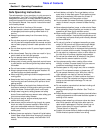
21
Section 2: Operating Procedures
8/26/08
ZT60 & ZT72 Zero Turning Radius Mowers Riding Mowers Accu-Z
®
357-103M
Land Pride
Table of Contents
Mower Deck Operation
!
DANGER
Never attempt to make any adjustments to the mower deck
while the engine is running or when the blades are engaged.
Mower blades cannot be seen and are located very close to
deck housing. Fingers and toes can be cut off instantly.
With engine running at a medium speed, engage blades
(Refer to Figure 2-11). Advance engine throttle to full rpm
once the blades have become fully engaged.
Blade Engagement Switch
Figure 2-11
General Operating Information
After thoroughly familiarizing yourself with the Operator’s
Manual and completing the Operator’s Checklist, you are
almost ready to begin mowing.
!
CAUTION
Mower deck and operator platform can be slippery when wet.
Always make sure your footing is secure when climbing onto
the mower to be seated.
Approach the mower from the front and make sure the
steering levers are spread fully apart in parking brake
position. Stand just to the outside rear of the left front
anti-scalp wheel and with your right hand grab the left
side steering lever for support. Be careful not to slip while
climbing onto the mower to be seated. Step up onto the
operator’s platform and comfortably seat yourself. With
NOTE: Engaging blades at high engine rpm or
when under heavy load (in tall grass for example)
can cause belts to slip, resulting in premature wear
or possible damage.
23686
Blade
Engagement
Switch
both steering levers still wide apart, reach for the throttle
and choke control to your right side. Position the throttle
control at half throttle and pull choke to the “up/on”
position. Insert your ignition key and rotate the ignition
key clockwise until you hear the engine begin to start.
Release the ignition key and push the choke to “down/
off” position. Allow the engine to warm up momentarily. If
your mower has just been running and the engine is
already warm, using the choke is probably not
necessary.
With the engine at half throttle reach forward and bring
both steering levers equally together in the neutral
position just in front of you. It’s now time to test your
steering skills. Gently push both steering levers equally
forward. The farther forward you push the levers the
faster you will go. Pull back equally and you will slow
down coming to a stop when you reach the neutral
position. Now slowly pull the levers back toward your
body past neutral position. The mower will reverse
direction and increase in speed as you pull further back.
If you push one lever forward and pull one lever back the
mower will do a Zero turn in the direction of the steering
lever closest to your body. Now take a few moments in a
safe area to practice maneuvering and steering your
mower with the engine still at half throttle. Gradually
increase your throttle speed until you feel totally
confident of your mower steering and handling ability
around obstacles and in tight areas.
It’s now time to cut the grass. Hopefully you have already
removed any obstacles from the lawn that you do not
want run over. With your mower at half throttle, place
your right foot on the deck lift pedal and release and
lower the deck to your preset cutting height. With your
right hand, pull up on the cutting blade engagement knob
and increase the engine speed to full throttle. You may
now begin mowing. If you haven’t already done so, you
may want to put the front axle in float mode which will
significantly smooth out the ride and deliver improved
traction capability over uneven ground. The front axle
can be quickly put back into the rigid mode if you need to
keep the deck up when doing overhanging cuts along
curbs or other landscape obstacles.
When you are done mowing or just want to take a break,
make sure you do all of the following.
• Park on level ground if possible
• Disengage cutting blades
• Throttle back
• Leave steering levers in wide-open parking brake
position
• Turn engine off
• Remove ignition key
• Step carefully off the left front corner of the operator’s
platform
• You may want to chock the wheels as an added
measure of safety, if and when you must park on an
incline.


















